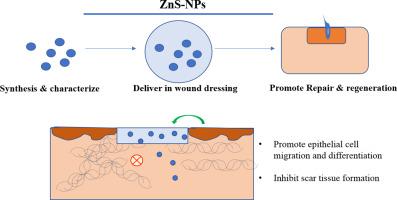Nanomedicine: Nanotechnology, Biology and Medicine ( IF 4.2 ) Pub Date : 2020-07-06 , DOI: 10.1016/j.nano.2020.102263 Bo Han 1 , William H Fang 2 , Shuqing Zhao 2 , Zhi Yang 2 , Ba X Hoang 2

|
Wound healing has been intensely studied to expedite recovery times and reduce scarring. However, current technologies fail to achieve regenerative capabilities, leaving wounds with scarring and lack of skin accessories. The recent emergence of nanotechnology has provided a new clinical modality of zinc nanoparticles in wound care. This present study investigated Zinc Sulfide nanoparticles (ZnS-NP) on wound healing in vitro with 2D and 3D models and in vivo with rat full-thickness wound model. ZnS-NP inhibited fetal bovine serum-stimulated rat skin fibroblast cell proliferation, altered cytoskeletal organization, and reduced collagen synthesis as well as contractile activity. ZnS-NP regulated redox homeostatsis and promoted fibroblast viability in 3D hypoxia conditions. In the rat full-thickness wound model, ZnS-NP reduced wound contraction, enhanced re-epithelization, and promoted skin appendage formation. The biological activities of ZnS-NPs determined in our current study may suggest promising practical applications for topical or systemic treatment for wound repair.
中文翻译:

硫化锌纳米颗粒改善皮肤再生。
伤口愈合已得到广泛研究,以加快恢复时间并减少疤痕。然而,当前的技术不能实现再生能力,从而使伤口具有疤痕和缺乏皮肤附件。纳米技术的最新出现为伤口护理提供了锌纳米颗粒的新临床方法。本研究研究了硫化锌纳米颗粒(ZnS-NP)在体外用2D和3D模型以及在体内用大鼠全厚度伤口模型的伤口愈合情况。ZnS-NP抑制胎牛血清刺激的大鼠皮肤成纤维细胞增殖,改变细胞骨架组织,并减少胶原蛋白合成以及收缩活性。ZnS-NP调节氧化还原稳态,并在3D低氧条件下促进成纤维细胞的活力。在大鼠全层伤口模型中,ZnS-NP减少了伤口的收缩,增强了再上皮作用,并促进了皮肤附件的形成。在我们目前的研究中确定的ZnS-NPs的生物学活性可能表明在伤口修复的局部或全身治疗中有希望的实际应用。











































 京公网安备 11010802027423号
京公网安备 11010802027423号